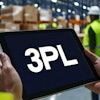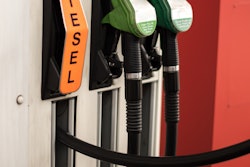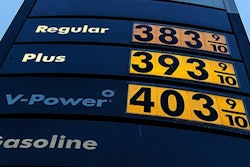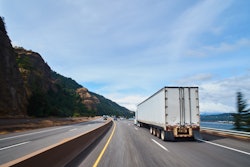
The economic impact of Russia’s invasion of Ukraine—when combined with the post-pandemic supply and demand challenges—has seen US gas prices spike to the highest ever nationally recorded. Biden’s recent plan to release up to 180 million barrels of oil from a strategic reserve intends to counteract that rising national gas price, which peaked at $5.13 for a gallon of diesel.
As a short-term solution, it is perfectly sensical. But simply tapping into oil reserves to address gas price inflation will not be effective in the long-term. Reports that look closely at the average yearly operational costs to operate heavy-duty trucks tell a useful story about often overlooked metrics like tire pressure. Lack of optimization of those metrics can have a huge, compounding effect on supply chain costs, ultimately passed on to the consumer at the pump.
Fuel takes up 21% of the yearly $210,000 price tag needed to operate a single truck, equating to more than $44,000. Given that $44,000, tire pressure and the rolling resistance of tires can add an additional 25% to that cost, or $11,000. Multiplying those costs by every truck on the road signals a massive fuel inefficiency which needs to be addressed to mitigate the feedback loop connected to rising gas prices.
Below are three steps fleets can take to optimize the tire pressure of their trucks while also lengthening tire life to benefit drivers, fleets, the supply chain at large, and consumers at the pump.
Upgrade the Baseball Bat
The “thumper” or baseball bat is still the tool of choice for many drivers performing pre- and mid-drive tire pressure inspections. In actuality, a trucker can’t accurately identify tire pressure using a baseball bat – it will only reveal to the driver wielding it if a tire is dangerously flat.
Tire companies with exhibition booths at major trucking shows often stage contests for truckers to test tire pressure using a baseball bat in an effort to demonstrate the uncertainty of the reading. Kicking truck tires with a boot on is rarely an accurate tell, either.
Even stick tire pressure gauges lauded by many tire companies have their shortcomings. Considering the spring stiffness coefficient varies from gauge to gauge, analog stick reader results largely vary. Regardless of manufacturer, a stick tire pressure gauge is only accurate to plus or minus (+/-) 3 PSI brand new out of the box. Further, dropping a stick gauge from steering wheel height onto the hard concrete surface can cause the plastic piece with the PSI numbers to regress to +/- 5 PSI with only one drop. Digital gauges provide a bit more accuracy but are even more uncommonly used.
The good news is that modern and more precise solutions do exist. Integrated platforms for tire pressure monitoring with in-cab visibility help to lower accident risks and drive fuel efficiency. With these insights at hand, fleet managers and drivers can make data-driven decisions to improve the efficiency of their operations and ensure that all their tires are properly inflated, minimizing the tire pressure differential’s contribution to gas prices and supply chain costs.
Consider Maintenance and Servicing Automation
Integrated systems allow dispatch and technicians to see tire pressure and temperature alerts for every tire on every vehicle. They remotely see status on the exact tire that is low, which generates tire pressure alerts directly to the platform’s web portal, functioning as a one stop shop for fleet management.
Adoption of tire pressure monitoring technologies helps fleets to automate scheduling based on vehicle usage and other readings within their maintenance system. Additionally, these systems can instantly provide verified visual inspection defect data to alert maintenance about serious defects mere seconds after the driver sees them. Otherwise, if maintenance is left up to a series of predetermined checkpoints equipped with shop stick gauges, drivers will see a large range of pressure readings unless those gauges are calibrated with a master gauge or air gauge checking station.
Preventive maintenance programs built around the needs of each specific vehicle help calculate fuel efficiency and cut idle time, while optimizing the tires, hardware, and other accessories for longevity that fleets already equip their vehicles with. That directly equates to quicker route times, less fuel burned, and lower fuel prices, given the scarcity across the board for consumers.
Make Use of the Latest in Route Optimization
Route optimization technologies know not every fleet consists of one type of commercial vehicle. Customized routes for each vehicle consider the vehicle type, dimensions, size, and load, and can also accommodate route preferences and the number of stops required to adhere to long haul rules. Maximizing route speed and minimizing driver hours used can seriously improve upon the fleet’s bottom line.
Each driver decision and traffic condition can have drastic effects on individual vehicles’ fuel efficiency. Beyond that, improper tire inflation due to overuse or ineffective pressure regulation makes vehicles three times more likely to be involved in a crash related to tire problems. GPS-based navigation technologies help drivers to avoid delays and detours by offering route updates on the fly, reducing the risk that a vehicle’s tire pressure is off due to unnecessary drive time, ensuring the vehicle burns less fuel, and lowering the chance of accident.
Similar to how the driver shortage cannot be fixed in the long-term by simply adding more drivers, tapping into oil reserves can only accomplish so much. Retiring the old, ineffective methods of regulating truck tire pressure will have a more lasting, reverberating effect – making use of smart, connected technologies will not only ensure that goods and deliverables make it from end to end faster, but will guarantee a reduction in gas used, reflecting in prices at the pump and supply chain costs at large.

![Pros To Know 2026 [color]](https://img.sdcexec.com/mindful/acbm/workspaces/default/uploads/2025/08/prostoknow-2026-color.mduFvhpgMk.png?auto=format%2Ccompress&bg=fff&fill-color=fff&fit=fill&h=100&q=70&w=100)







![Pros To Know 2026 [color]](https://img.sdcexec.com/mindful/acbm/workspaces/default/uploads/2025/08/prostoknow-2026-color.mduFvhpgMk.png?ar=16%3A9&auto=format%2Ccompress&bg=fff&fill-color=fff&fit=fill&h=135&q=70&w=240)






